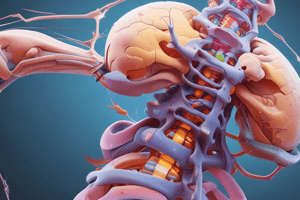Podcast
Questions and Answers
What is the primary function of the labial frenum in the mandible?
What is the primary function of the labial frenum in the mandible?
- Provides support for the posterior denture flange.
- Serves as a relief area for denture displacement.
- Acts as a sensitive attachment point for the orbicularis oris muscle. (correct)
- Creates lateral stability for the tongue.
Which structure is found within the buccal vestibule?
Which structure is found within the buccal vestibule?
- Buccinator muscle (correct)
- Lingual frenum
- Retromolar pads
- Mental foramen
What anatomical feature is formed due to the activation of the lingual frenum?
What anatomical feature is formed due to the activation of the lingual frenum?
- Lingual notch in the denture (correct)
- Alveololingual sulcus
- Relief area in the buccal shelf
- Crest of the residual alveolar ridge
What is the primary importance of the labial vestibule in denture design?
What is the primary importance of the labial vestibule in denture design?
Which anatomical landmark is involved in supporting structures of the mandible?
Which anatomical landmark is involved in supporting structures of the mandible?
What is the main function of the retromolar pad in denture construction?
What is the main function of the retromolar pad in denture construction?
Which structure is located at the anterior region of the alveololingual sulcus?
Which structure is located at the anterior region of the alveololingual sulcus?
Where does the mylohyoid muscle arise in relation to the mylohyoid ridge?
Where does the mylohyoid muscle arise in relation to the mylohyoid ridge?
What is the characteristic feature of the middle region of the alveololingual sulcus?
What is the characteristic feature of the middle region of the alveololingual sulcus?
What is the clinical significance of the external oblique ridge in denture fitting?
What is the clinical significance of the external oblique ridge in denture fitting?
Flashcards are hidden until you start studying
Study Notes
Limiting Structures
- Labial Frenum: A fibrous band similar to the maxillary labial frenum, but unlike it, is active and gets narrower when the mouth opens wide.
- Labial Vestibule: The space between the residual alveolar ridge and the lips, important for lip support and denture retention.
- Buccal Frenum: Attached to the buccinator muscle fibers, needs relief to prevent denture displacement during function.
- Buccal Vestibule: Extends posteriorly from the buccal frenum, bound by residual alveolar ridge and the buccinator muscle.
- Lingual Frenum: A fold of mucous membrane that extends along the floor of the mouth, producing a lingual notch in the denture.
- Alveololingual Sulcus: Extends from the lingual frenum to the retromylohyoid curtain, divided into three regions:
- Anterior Region: Extends to the premylohyoid fossa where the flange is shorter anteriorly and touches the mucosa of the floor of the mouth when the tongue touches the upper incisors.
- Middle Region: Extends from the premylohyoid fossa to the distal end of the mylohyoid ridge, shallower than other parts of the sulcus.
- Posterior Region: Features the retro-mylohyoid fossa and requires the denture flange to turn laterally to fill the fossa.
- Retromolar Pad: Soft elevation of mucosa distal to the third molar, important for support and peripheral seal, requiring the flange to turn laterally to fill the fossa.
- External Oblique Ridge: A ridge of dense bone extending from the mental foramen superiorly and distally, sometimes a guide for buccal flange termination.
- Mylohyoid Ridge: Irregular bony crest on the lingual surface of the mandible, near the inferior border anteriorly, becoming higher posteriorly.
Supporting Structures
- Buccal Shelf Area: Area between the buccal frenum and the anterior border of the masseter, bound by the crest of the ridge, retromolar pad, and external oblique ridge.
- Residual Alveolar Ridge: The bony process remaining after tooth loss, varies in size and shape between patients, not ideal for primary stress bearing due to spongy bone.
Relief Areas
- Mental Foramen: Located on the external surface of the mandible between the 1st and 2nd premolar area, requires relief to prevent pressure on nerves and blood vessels.
- Genial Tubercles: Pair of bony tubercles on the lingual side of the mandible, may become prominent due to resorption, requiring relief.
- Torus Mandibularis: Abnormal bony prominence found bilaterally on the lingual side, covered by thin mucosa, may require relief or surgical removal.
Studying That Suits You
Use AI to generate personalized quizzes and flashcards to suit your learning preferences.




